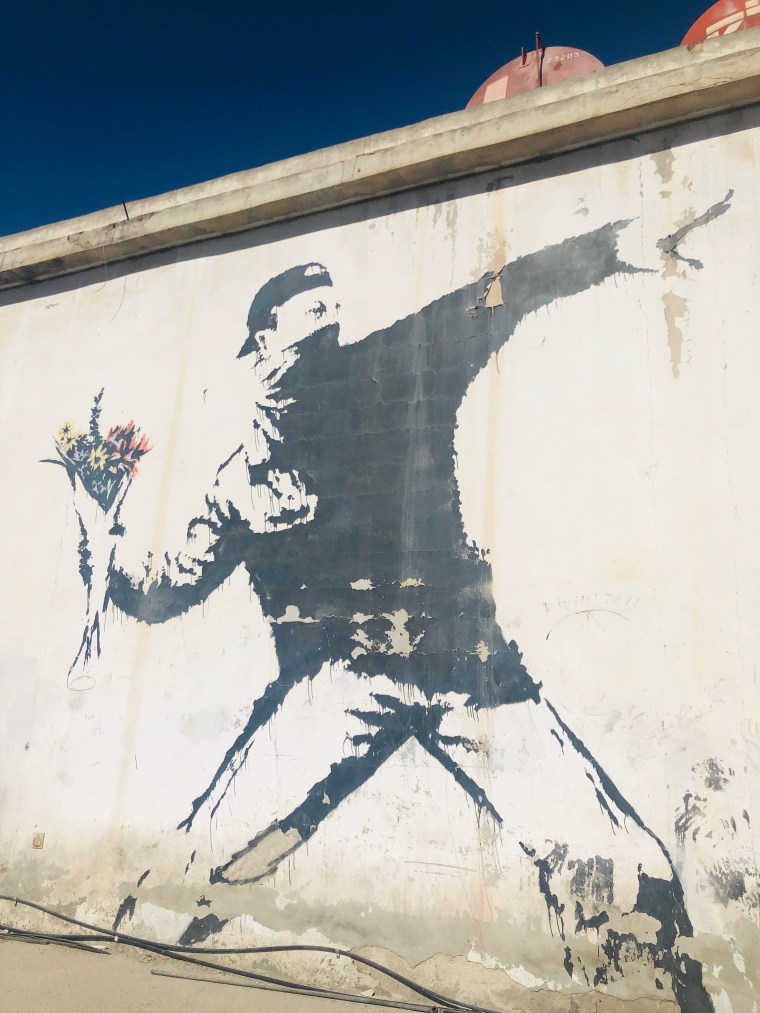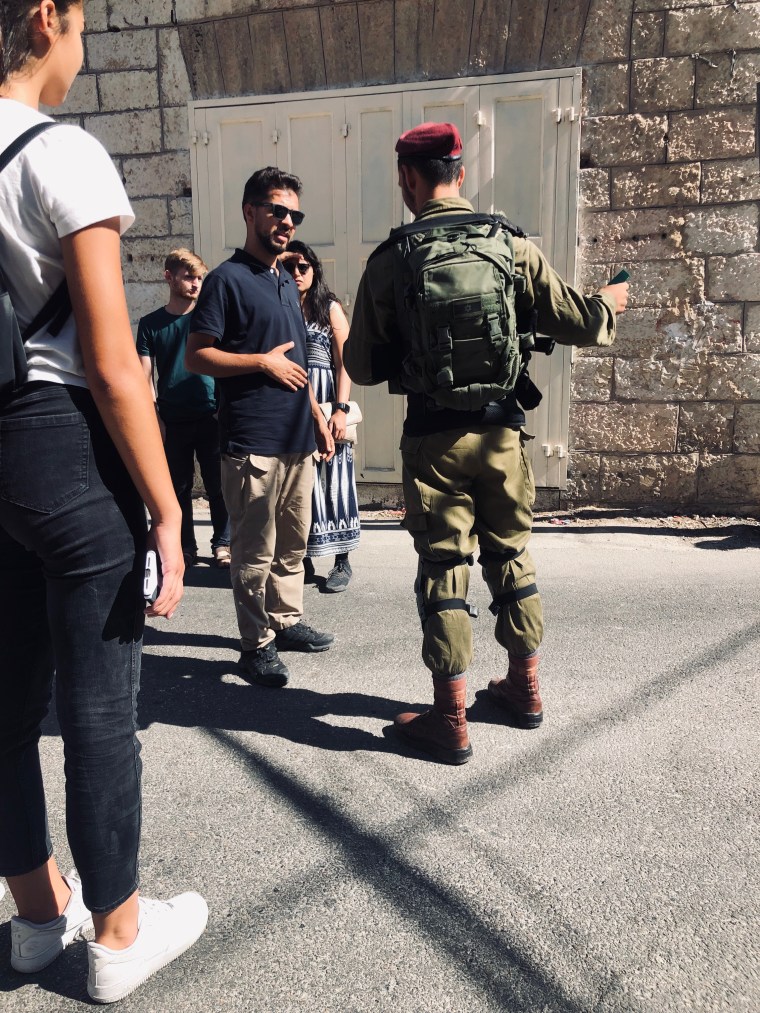Here we are: the actual reason for my trip to Israel-Palestine!
I didn’t really discuss this in my blogs from last spring, but I spent a sizable chunk of time before spring break writing a grant proposal to go to Jerusalem to do some research. It was a long shot — I never thought I’d actually get the money to go, and I mostly considered it an experiment with the grant-writing process (which I had only done once before, to go to Vichy for a week-long language intensive in French) that would be useful practice for later.
The plan to go to Israel-Palestine stemmed from the time I’ve spent over the last two years working with the Madrasa Discourses project, for the conciliation of traditional Islamic thought with modernity in India and Pakistan. The idea first came from a friend that I made while in Doha with an MD conference. She was the one who originally proposed turning our experiences with Madrasa Discourses and interreligious dialogue into an independent project, and so I owe it to her for inspiring me to actually go through with the whole undertaking.
Though she ultimately couldn’t go, which was a huge factor in determining my level of comfort going to a politically tense area like Jerusalem, I still decided to do it. You don’t get a grant from your university to do research every day — especially when the research takes you to a country and a culture you’ve experienced been before.
There have been many famous walls throughout history – the Great Wall of China, the Berlin Wall, the of Northern Ireland Peace Lines – and now a new barrier wall has joined their ranks.
This barrier wall is the West Bank barrier, which separates the Muslim-dominant Palestine from the Jewish-dominant Israel. Described by Israelis as a “security fence” (geder-ha-hafrada) and by Palestinians as an “apartheid wall” (jidar al-fasl al-‘unsuri), the barrier has been a subject of controversy ever since its construction began in 2002. Out of controversy and political unrest, however, can spring one of the most passionate and creative forms of self-expression: art.

Much like what was seen in Berlin and Belfast, artists in Jerusalem have transformed the concrete that separates Israel and Palestine into a canvas for political discussion. On either side of these walls, activists, professional artists, and civilians have used graffiti as a way to express opinions about the situation in Israel-Palestine and the barrier’s existence.
During the course of my one-week journey to Israel-Palestine, I studied this political graffiti on the West Bank border wall, focusing specifically on the area around Bethlehem. My goal was to discover some of the artistic themes on the wall and how those reflected local sentiment about the ongoing Israel- Palestine conflict. More specifically, I wanted to study how the opposing narratives of the border wall as a “security fence,” as it is referred to by many Israelis, or as an “apartheid wall,” as it is referred to by many Palestinians, were evident in the wall’s artwork.
If you’re not familiar with the situation in Israel-Palestine surrounding the border wall, here’s a little context: the border was initially constructed by Israel to protect against extremist Palestinian bombings, and to many Israelis, it has done its job well. In 2004, approval of the wall for Jewish-Israelis was at 78%, with many arguing that it had caused the shift from nearly-weekly bombings in 2003 to only three attacks in 2004. 
However, though the barrier primarily follows the Green Line (a 1948 armistice border acknowledged by the UN), it swerves east several kilometers to incorporate certain Israeli settlements. To many Palestinians, this is nothing short of occupation and land grab. The wall cuts off many Palestinian citrus and olive farmers from their land, making it difficult or impossible for them to harvest their crops because of the new security checkpoints. Crossing the checkpoints from Palestine-controlled Bethlehem to get into Israel-controlled Jerusalem also poses many problems for Palestinians; people begin queuing hours in advance on weekday mornings so that they can get to their jobs in Jerusalem. Many simply bypass the checkpoints and cross the border illegally every morning instead — something Israeli employers easily take advantage of by refusing to pay “illegal” Palestinians for labor they have already completed.
With this background in mind, I began my preliminary research by taking a graffiti tour with a Palestinian guide. This initial tour was crucial, as he was able to point out key pieces of art (such as those by famous English graffiti artist Banksy) and direct me to other wall-related graffiti that was in the area but not necessarily on the wall itself. I came back at a later date to actually scrutinize individual pieces and photograph the wall itself; this first day was just to get my bearings with the help of a local. With this as my main goal for the day, I was able to relax a little and just enjoy learning.

Due to the constantly changing nature of graffiti, some of the pieces that I had seen online when I had been doing research for my grant proposal had been completely removed or covered by new pieces of graffiti. For example, one, which had previously depicted President Trump and Prime Minister Netanyahu in a kiss, had been altered to remove their embrace. It may be interesting to go again in a year or so to see how the visible graffiti has changed — which pieces have been scrubbed away, or covered up by other graffiti, or had their message altered.
My guide also took me into Bethlehem to see a Palestinian refugee camp, where I got to talk to some locals (including an elderly man who rememberd when the Palestinians were orignally evicted from their homes in 1948 during what is known to Israelis as their War of Independence and known to Palestinians as The Nakba, meaning “the Catastrophe” in Arabic). Seeing the lives of Palestinians as they went about their days was honestly just as impactful as the graffiti. At one point, we had to cross into a piece of territory that was technically under the control of Israel. We, as foreigners, were allowed in but our Palestinian guide was stopped by IDF soldiers before he even got to the checkpoint.

But it wasn’t all politics and gloom — we visited a part of Hebron, where we saw a glassblowing workshop. We also saw the Church of the Nativity in Bethlehem, the (honestly, kind of tacky) Crusade-era church built to commemorate the supposed birthplace of Jesus. And we got lunch at a really lovely Palestinian cafe, which was still open despite the fact that it was a Muslim holiday and most places were closed.

When I originally wrote this grant proposal, I had hoped to learn about both sides of the Israel-Palestine conflict through the artwork on the wall. As it turned out, there wasn’t much artwork on the Israeli side at all, nor was there much artwork on the Palestinian side that might be described as “pro-Israel.” I thought that this might be the case going in — graffiti often being used more as a vessel for protest rather than praise — so my trip helped to confirm my belief.
Because I actually visited Palestine/the West Bank, rather than just viewing images of the wall online, I actually got a sense of what life is like for the Palestinians who live behind the wall. Perhaps most apparent was the great wealth disparity that was immediately visible as soon as I crossed from Jerusalem to Bethlehem. They feel like worlds apart — one is relatively safe, modern, and comfortable, and the other looks more like what you’d imagine a war zone in the Middle East to be. The massive concrete wall, guard towers, and IDF soldiers watching you from above doesn’t help.

Do I recommend that you go to the wall itself? Personally, I feel a little conflicted about the concept of political tourism, because actual people’s lives aren’t something to be gawked at and photographed like animals at a zoo — however, it’s critical to educate yourself about the history and political context of the places you go, and one of the best ways to do that is simply to pay a visit to a contested area. Each city has one– it’s Freedom Square in Budapest, it’s the Opéra in Vichy.
As the quote goes, travel is fatal to prejudice, bigotry, and narrow-mindedness. Respect the people you encounter, don’t treat it like it’s another tourist destination for Instagram, and share what you see if it so moves you to consider a different perspective or narrative than you thought you knew.
If you ever get the chance to visit Israel-Palestine, I highly recommend popping over to the West Bank to get the Palestinian story. Whatever you decide, do as the writing on the wall says, and “don’t be a brick in this wall.”
That’s about it for today. Thanks for reading, and I’ll see you in the next one with more updates on my trip to Israel-Palestine this summer. Don’t forget to check me out on Pinterest, Instagram, Facebook, Bloglovin, Twitter, and Tumblr! For business inquiries, shoot me an email at lensembledujour@gmail.com!
Top: Zara
Coat: Forever21
Trousers: Altar’d State

